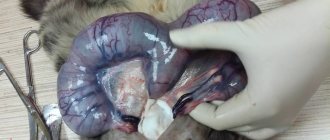Whether or not to sterilize your furry pet is up to each owner to decide for himself. Many veterinarians believe that if you do not intend to breed offspring, then sterilization is the only correct solution. But it is worth understanding that it has both positive and negative consequences. Only after weighing all the pros and cons can you make the right decision and discuss it with a specialist.
Is it possible to spay a cat during her first heat?
An animal is spayed during its first heat only if there are any veterinary indications. If an animal has gynecological diseases, they resort to surgical intervention. Pyometra is often found in young cats - this is when purulent discharge is observed from the genitals during the period of estrus. In this situation, it is not recommended to wait until this period has passed, as sepsis may begin to develop.
The animal behaves inappropriately during the period of heat. It is best to give sedatives during sexual heat. Sterilization is done after the estrus is over, it will be safe for the animal.
The best option is to undergo surgery before the first sexual desire; this will help reduce the development of gynecological diseases. You need to wait until the heat is over, and only then do the operation.
Signs of estrus
To attract males, females use 2 tools: voice and smells. All sounds made become rougher and louder. Frequent but light urination occurs not only in the litter box - the pet leaves odorous marks on vertical and horizontal surfaces. Raising her tail and turning her back towards the target, she secretes a few drops of urine.
Another way to place marks is by rubbing them on objects. The glands on the cheeks of furry pets secrete a special secretion, allowing them to leave an individual scent.
The signs of the first menstruation are identical to subsequent ones. They are distinguished only by their weak expression in young animals.
Remember that discharge during “critical days” should be transparent. The appearance of blood or pink clots is a dangerous symptom that requires diagnosis.
When is the best time to spay a cat?
It is best to have your cat spayed between six and ten months of age. Each animal is individual, and complete puberty may vary in time. Many purebred cats undergo surgery at around five years of age. Most veterinarians say that young animals are the easiest to tolerate sterilization and anesthesia.
There are the following benefits of sterilizing your cat:
- An individual who does not know what estrus and sexual desire are will find it easier to psychologically experience surgical intervention.
- Cats that have not given birth have a reduced risk of developing malignant neoplasms.
- Early sterilization helps to avoid infections that are transmitted through sexual intercourse.
- Castration prevents the development of urolithiasis in cats.
If you refuse sterilization and give the animal hormone-based medications, a hormonal imbalance will occur. This will ultimately lead to inflammation of the genital organs. Therefore, it is best to do sterilization in a timely manner so that various pathologies do not develop.
Maybe we should not?
Can a cat be spayed while in heat? We will definitely find out the answer to this question, only a little later. For now, let’s talk about whether it’s worth interfering in a cat’s life at all.
Why don’t owners deprive their pet of reproductive internal organs? Common reasons:
- You need it once for your health.
- I want kittens.
- The cat should feel like a mother.
- This is dangerous for her health.
- It's against nature.
- Not humane, period.
Now we will consider these points in detail. It’s necessary for health, then? Cats do not derive any pleasure from sexual intercourse, unlike humans. On the contrary, females experience pain. The pain of conceiving kittens, then 60 days of restructuring the body, then painful childbirth and feeding the cubs. When the kittens are a month old, the mother cat looks exhausted and very thin. What's the health like there?
I want kittens. To whom? To the cat? Hardly. Rather, the owners. One can understand the owners of expensive purebred animals with excellent pedigree and top marks at exhibitions. Such kittens cost a lot of money, and it’s clear why a cat is bred.
But if Murka the noblewoman gives birth to children, where will they go next? Give it to friends? Alas, most often no one needs outbred kittens. Throw it out onto the street? Destroy? Keep the entire litter for yourself? Not the best options.
The cat should feel like a mother. Did she say that herself? Or did the owner decide? The cat doesn't owe anything.
This is dangerous for her health. Much more dangerous are drugs such as “sex barrier”, which destroy the liver. Or a hormonal imbalance in the animal’s body.
It's against nature. The firmest belief, for some reason. People do many things in their lives against nature. And sterilizing a cat is not the worst among them.
This is inhumane. Is it more humane to drown kittens or euthanize them? Sterilization is the most humane method for preventing the birth of unwanted kittens.
Features of the rehabilitation period
With proper care after sterilization, the cat will recover in about a few days. Anesthesia does not negatively affect the animal's body when a normal amount of anesthesia is administered.
Proper rehabilitation proceeds as follows:
- The animal must walk in a special bandage for about one week. If your pet is very active, it is recommended to wear a collar; it will help prevent licking and tearing of the seams.
- For about a week, the pet should be given food in liquid or canned form so that there is no heavy burden on digestion.
- You need to limit your pet's physical activity for two weeks. We must stop playing with the animal and not allow children to spend time with it. If there are heavy loads, the seams tend to separate.
- The wound will need to be looked after, wiped daily with miramistine or chlorhexidine.
After sterilization, the animal will show less aggression and stop marking. After surgery, your pet's appetite will increase, so it is best to switch your pet to special food to avoid obesity.
Postoperative care
We recommend
After surgery, the animal remains under anesthesia for several hours. Upon arrival home, the owner needs to place the cat on a bed and cover it with a blanket, since anesthesia helps lower body temperature. It is recommended to lay the pet on its side and place a heating pad nearby.
You should turn the cat over every 30 minutes and gently close her eyes so that they do not dry out. It is important for the owner to ensure that, after regaining consciousness, the pet does not climb onto high surfaces, since after anesthesia, coordination of movements is impaired and the cat may fall and be injured.
About 24 hours after the operation the animal refuses to eat. Veterinarians from the Zoovet clinic categorically do not recommend forcing a cat to eat food. However, it is important to provide her with access to drinking water. At the same time, you need to ensure that your pet does not lose consciousness or choke.
We suggest you read: Proper feeding of cats with natural food: how and what to feed
You need to feed your pet every other day. It is recommended to feed wet food in small portions. It is better to pay attention to premium segment complementary foods, which are intended for animals that have undergone surgery. Such products contain the composition required for a weakened body and improve the functioning of the gastrointestinal tract. Cats often tend to lick the seams, so you need to purchase a special collar that can only be removed during feeding. The owner needs to treat the cat with maximum care and love, since the pet has experienced serious stress.
Is it possible to spay a cat during heat?
When a cat goes into heat, there is a rush of blood in the pelvic area, and the uterus enlarges, making removal more difficult. When sterilized during heat, hormonal imbalance may occur. Removing the uterus and ovaries disrupts the natural balance of hormones.
During estrus, the animal's body works from instincts. Many veterinarians say that performing surgery while out and about can leave you with no sexual desire. But in reality this is not the case; during sterilization, the hormones that are responsible for hunting are removed from the blood and everything returns to normal.
Minuses
To castrate a cat or not? The veterinarian's advice in this case is obvious. Yes, it is advisable to do this procedure. But you need to know about its disadvantages. There are only two of them, but in every barrel of honey there is a fly in the ointment.
Castration is an operation. It's worth remembering this. To avoid serious consequences, such as suture dehiscence and suppuration, you should follow all the doctor’s recommendations for caring for your cat after surgery.
Nowadays it has become popular to carry out this procedure at home. Better not, take your pet to the clinic. The fact is that sterilization and castration imply maintaining ideal cleanliness in the room. This can hardly be achieved at home.
What are the dangers of sterilization during estrus?
Performing surgery during estrus may have some health risks for the animal. When a cat is in heat, sex hormones are rampant in the blood, and it is best to refuse surgery unless there is an urgent need.
There are the following risks of sterilization during the heat period:
- During estrus, the vessels of the uterus dilate and the blood fills by 35%. Any mistake by the veterinarian during surgery can result in the death of the animal within a couple of minutes due to blood loss.
- Hormonal imbalance. During estrus, hormones are released into the blood and their sudden absence can lead to the development of cancer.
- There is a high probability that performing an operation at the time of sexual heat will lead to a change in the cat’s behavior in a negative direction.
It is best to wait until the heat is over to avoid various consequences. In rare cases, sterilization is carried out during the period of sexual hunting. The constant use of hormonal drugs against estrus poses a great danger to the health of the cat.
Introduction
How long does a dog's heat last? This question is asked by many owners of adult bitches who are seriously thinking about getting healthy puppies that fully meet breed standards.
The physiological processes occurring in the body of an adult bitch are in many ways similar to those occurring in the body of any female.
At a certain period of puberty, the bitch begins to have discharge, which is the main sign of her readiness to mate and bear offspring.
To determine estrus, veterinary medicine uses a term such as estrus.
When can a cat be spayed after being in heat?
Veterinarians say that you need to wait some time after the end of sexual hunting. This is necessary so that the cat can be in a calm state. If the pet shows aggression and constantly screams, then the operation should be performed almost immediately after estrus.
Sterilization should not cause concern to the owner, because surgical intervention can prevent the development of a large number of diseases. After sterilization, the animal becomes affectionate, calm and stops marking. The most important thing is to maintain proper nutrition and it is best to switch to food to avoid excess weight in the cat.











